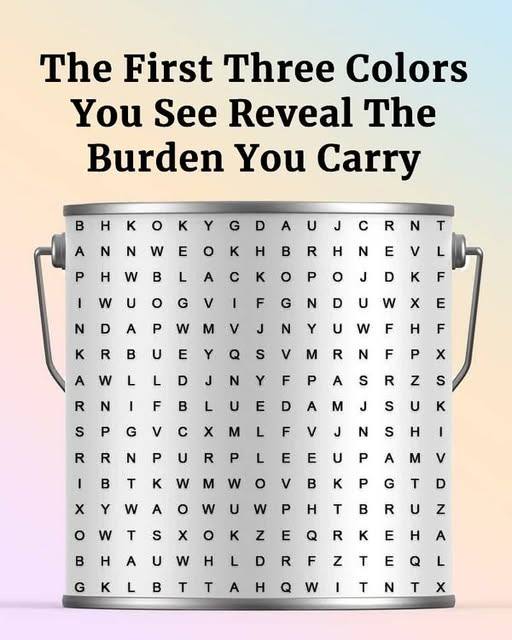Can Colors Reveal the Emotional Weight You Carry?
What if the colors that catch your eye first thing in the morning—or anytime—aren’t just random? What if they’re quietly reflecting something deeper: your emotional state, unresolved feelings, or even your hidden struggles?
Color isn’t just about aesthetics. It’s a powerful language your mind and body might already be speaking.
How Colors Affect Us Emotionally
Colors influence how we feel more than we might realize. Think of how calm blue skies feel, or how red warning signs instantly grab your attention. That’s not accidental—our brains and emotions are wired to respond to color.
Here’s a quick rundown of how color perception works:
- Your eyes take in light.
- Cone cells in your retina interpret that light into colors (mainly red, green, and blue).
- Your brain then adds emotional meaning, based on personal memories, cultural background, and psychological state.
In short: color is both a biological process and a deeply personal experience.
What the First Colors You Notice Might Reveal About You
🔴 Red – The Weight of Intensity
If red stands out to you, you might be carrying:
- Suppressed anger or frustration
- Strong desires or passions you haven’t expressed
- Inner tension that needs to be released
- A need for firmer emotional boundaries
Red often points to energy that’s trapped or unresolved—something wanting to be acknowledged.
🔵 Blue – The Depth of Emotion
If blue is what you see first, it may signal:
- Emotional exhaustion or sadness
- Longing or deep reflection
- A need for healing or solitude
- Hidden vulnerability
Blue reveals an emotional burden rooted in quiet introspection. It asks you to listen inward.
🟣 Purple – The Sign of Inner Transformation
Purple often shows up during big internal shifts. It might mean:
- You’re undergoing a personal or spiritual transformation
- You’re facing internal conflicts about your identity
- You feel caught between who you were and who you’re becoming
Purple speaks to growth—even when it’s uncomfortable.
Why This Works: The Science Behind It
This isn’t just about guesswork. Our emotional response to color is shaped by:
- Memory: We link colors to moments and emotions from the past.
- Culture: Different cultures attach different meanings to colors.
- Subconscious response: Sometimes colors stir up feelings we don’t even realize we’re holding.
- Brain activity: Specific colors trigger different areas of the brain.
And yes, even mindfulness and personal growth can actually change how we experience color.
How to Use Color to Understand Yourself Better
Try using color as a self-awareness tool. Here’s how:
- Pay attention: What colors draw your eye repeatedly? That might be a clue.
- Journal it: Write down your color experiences and how they made you feel.
- Create with color: Try drawing, painting, or just surrounding yourself with specific hues.
- Use it in therapy: Many therapists now use color-based tools to help people understand and heal.
But Don’t Overthink It—Use Color as a Guide, Not a Rule
This isn’t a test with right or wrong answers. It’s a conversation with yourself. Color can point to emotional patterns, but it’s not a substitute for therapy or mental health support.
The Future of Color Psychology
From high-tech color therapy apps to quantum theories of perception, science is diving deep into how color connects to our consciousness. Some exciting developments include:
- Personalized color environments (using AI to adjust lighting/moods)
- Mindful color training to enhance emotional intelligence
- Genetic research into why we see and feel colors differently
- Color-based therapy for trauma, anxiety, and depression
Reflection: Your Color, Your Clue
Ask yourself:
- What colors do I feel drawn to lately?
- What emotions do they stir up?
- Is there a connection to what’s going on in my life?
Colors are like mirrors—reflecting not just the world around you, but the world within you.
Final Thought
Next time a color catches your attention, don’t just glance and move on. Pause. Feel. Reflect. It might be your subconscious nudging you toward understanding, healing, or growth.
Because sometimes, the first three colors you see aren’t just a coincidence—they’re your soul whispering, “Hey… look deeper.”

Sophia Reynolds is a dedicated journalist and a key contributor to Storyoftheday24.com. With a passion for uncovering compelling stories, Sophia Reynolds delivers insightful, well-researched news across various categories. Known for breaking down complex topics into engaging and accessible content, Sophia Reynolds has built a reputation for accuracy and reliability. With years of experience in the media industry, Sophia Reynolds remains committed to providing readers with timely and trustworthy news, making them a respected voice in modern journalism.
